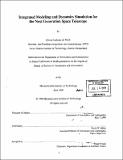Integrated modeling and dynamics simulation for the next generation space telescope
Author(s)
De Weck, Olivier Ladislas, 1968-
DownloadFull printable version (20.88Mb)
Other Contributors
Massachusetts Institute of Technology. Dept. of Aeronautics and Astronautics.
Advisor
David W. Miller.
Terms of use
Metadata
Show full item recordAbstract
The Next Generation Space Telescope (NGST) represents a challenging problem from the point of view of maintaining a milli-arcsecond level pointing accuracy and diffraction limited wavefront performance in the presence of dynamic onboard disturbances during science observations. This is due to the fact that NGST will make extensive use of deployable, inflatable and lightweight components, which leads to high modal density and light damping of the structural plant. An integrated model comprising multiple disturbance sources, structures, optics and control systems was developed in order to predict the expected dynamic performance of the observatory in terms of wavefront error and line-of-sight jitter. A simple three degree-of-freedom system is used to motivate the analysis and to develop the equations before applying them to the full order observatory. An initial performance assessment showed that the conceptual design model based on the NASA Goddard "Yardstick" concept for NGST cannot meet performance assuming a set of nominal design parameters stipulated by the author. This performance assessment is carried out using time domain, frequency domain and Lyapunov techniques. Two strategies for dealing with large order models using numerical conditioning and singular value decomposition of the optics linear sensitivity matrices have been demonstrated. A sensitivity analysis revealed which parameters contribute significantly to the root-mean-square errors. This information was subsequently used to recommend performance improvements including stiffening the secondary mirror tower, isolating reaction wheel disturbances and adding passive damping treatments. A repeated performance analysis and time simulations using NASA's non-linear simulation model of NGST showed that performance can be met with comfortable design margins by applying a combination of the suggested redesign actions on the nominal design. This research is motivated by the fact that it will not be possible to test the fully deployed observatory in a 1g environment before launch.
Description
Thesis (S.M.)--Massachusetts Institute of Technology, Dept. of Aeronautics and Astronautics, 1999. Includes bibliographical references (p. 216-220).
Date issued
1999Department
Massachusetts Institute of Technology. Department of Aeronautics and AstronauticsPublisher
Massachusetts Institute of Technology
Keywords
Aeronautics and Astronautics.